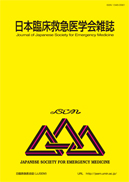Volume 17, Issue 6
Displaying 1-13 of 13 articles from this issue
- |<
- <
- 1
- >
- >|
original article
-
2014Volume 17Issue 6 Pages 731-736
Published: December 31, 2014
Released on J-STAGE: January 24, 2015
Download PDF (449K)
research
-
2014Volume 17Issue 6 Pages 737-742
Published: December 31, 2014
Released on J-STAGE: January 24, 2015
Download PDF (600K) -
2014Volume 17Issue 6 Pages 743-747
Published: December 31, 2014
Released on J-STAGE: January 24, 2015
Download PDF (325K) -
2014Volume 17Issue 6 Pages 748-752
Published: December 31, 2014
Released on J-STAGE: January 24, 2015
Download PDF (399K) -
2014Volume 17Issue 6 Pages 753-760
Published: December 31, 2014
Released on J-STAGE: January 24, 2015
Download PDF (597K) -
2014Volume 17Issue 6 Pages 761-765
Published: December 31, 2014
Released on J-STAGE: January 24, 2015
Download PDF (488K) -
2014Volume 17Issue 6 Pages 766-773
Published: December 31, 2014
Released on J-STAGE: January 24, 2015
Download PDF (676K) -
2014Volume 17Issue 6 Pages 774-781
Published: December 31, 2014
Released on J-STAGE: January 24, 2015
Download PDF (1051K) -
2014Volume 17Issue 6 Pages 782-788
Published: December 31, 2014
Released on J-STAGE: January 24, 2015
Download PDF (726K) -
2014Volume 17Issue 6 Pages 789-793
Published: December 31, 2014
Released on J-STAGE: January 24, 2015
Download PDF (372K)
case report
-
2014Volume 17Issue 6 Pages 794-799
Published: December 31, 2014
Released on J-STAGE: January 24, 2015
Download PDF (982K) -
2014Volume 17Issue 6 Pages 800-804
Published: December 31, 2014
Released on J-STAGE: January 24, 2015
Download PDF (633K) -
2014Volume 17Issue 6 Pages 805-808
Published: December 31, 2014
Released on J-STAGE: January 24, 2015
Download PDF (587K)
- |<
- <
- 1
- >
- >|
